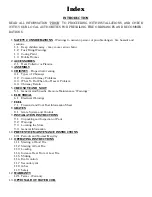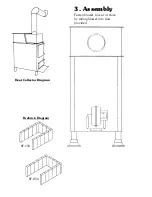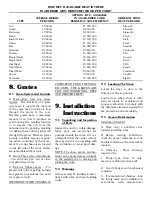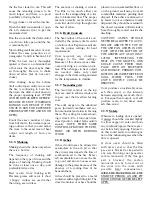
5
4. Chimney
4.1 Types of Chimneys
The chimney is one of the most
important, yet most neglected and
misunderstood portion of any solid
fuel burning installation. We do not
recommend that the stove be con-
nected to a chimney with other
heating devices.
THE STOVE MUST BE CON-
NECTED TO ITS OWN TILE-
LINED FLUE. A MINIMUM FLUE
SIZE OF 8" X 8" IS NECESSARY
FOR PROPER OPERATION AND
APPROVED FOR ALL FUELS.
UNDER NO CIRCUMSTA N C E S
SHOULD A MANUAL FLUE
DAMPER BE INSTALLED IN THE
SMOKE PIPE BETWEEN STOVE
AND CHIMNEY!
No damper, heat saver, or automat-
ic vent damper device should be
installed in or on the smoke pipe.
N O O T H E R A P P L I A N C E S
SHOULD BE VENTED TO THIS
FLUE!
CAUTION: THE CHIMNEY MUST
BE A CLASS “A” CHIMNEY IN
GOOD OPERATION CONDITION.
NOTE: THE USE OF ALUMINUM
TYPE “B” GAS VENT FOR SOLID
FUELS IS UNSAFE AND PROHIB-
ITED BY THE NATIONAL FIRE
PROTECTION
ASSOCIAT I O N
CODE.
There are three types of class “A”
chimneys:
A. Masonry with tile liner to
include brick or stone. It must be
supported on grade level founda-
tion.
B. Insulated Class “A” manufac-
tured chimney, listed or certified by
a national test agency.
C. Triple Wall Metal Class “A”
chimney, listed or certified by a
national test agency.
If your masonry chimney has not
been used for some time, have it
inspected by a qualified person
(building inspector, fire department
personnel, etc.). If a listed or certi-
fied manufactured chimney is to be
used, make certain it is installed in
accordance with the manufacturer’s
instructions and all local and state
codes. See Figure No. 1 of
Manufactured Chimney Installations
and Figure No. 2 of masonry
Chimney (note roof clearance) in
accordance with NFPA 211.
4.2 Common Chimney Pro b l e m s
In order to have a proper operating
solid fuel heating system, the chim-
ney must be capable of providing
the draft required.
The minimum required draft is .06
inches W.C. (water column). This
must be measured using a draft
gauge.
If the chimney cannot supply this
constant draft, the unit will not
operate properly.
In some installations, a barometric
draft regulator may be used and
properly adjusted to compensate for
excessive draft.
IMPORTANT!
Whenever you measure the draft,
the stove must be operating and suf-
ficient time given for the chimney
and stove to warm up. This should
take a minimum of thirty minutes.
The draft reading is taken 18" up
from the center of the stove flue
outlet in the smoke pipe.
REASONS for insufficient draft
readings:
A. Leaky Chimney - Air leaking in
a round a loose fitting clean-out
door, flue pipes not tight at the
joints, improper plug openings or
defective masonry.
B. Chimney Improper Height -
Chimney does not extend through
the roof to a sufficient height to pro-
mote sufficient draft or causes a
down drafting condition to take
place. (See Figure No. 3)
C. Obstructions in the chimney.
Check prior to using by holding a
mirror in chimney clean-out door.
This will give a view of the chimney.
D. Trees or Other Topographical
Barriers - Impeding the chimneys
operation or causing a down draft
condition to exist. This can also be
caused by adjacent buildings or the
roof of the same structure where the
chimney is not high enough. (See
Figure No. 3)
Figure 2
Figure 1
Summary of Contents for SF-150 SF-250
Page 18: ...17...





































